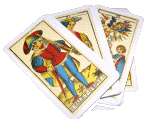
Bohemian Gothic Tarot
VII THE CHARIOT
Lighter or more conventional meanings
Focus and drive * Strong willpower * Conflict, warfare, imposing your will forcefully * Ruthless determination * Putting your own goals before all else * Insisting on having your way * Knowing where you are heading * Journeying, travelling * Means of transport - especially road transport.Darker, shadow or more hidden meanings
Out and out warfare * Destruction - riding "roughshod" over others * Megalomania, becoming power-mad * Losing your way, literally or metaphorically * Becoming confused about your focus, letting others drive you * A lust for war and conflict.The Chariot is one of those cards that often makes readers uncomfortable because it has such a range of meanings, from the mundane to the most serious. At one end of this scale it can refer simply to driving a car or any form of road transport. At the other, it indicates wars and warfare. It also refers in general to drive, direc�tion, goals and willpower. When this card appears in a reading it's important to ask when healthy passion and determination turn into brute force or a disregard for others' needs and wishes. It's good to get to where you want to go, but not when it's done at too high a cost.
The imagery of the historical tarot Chariot card is reminiscent of Petrarch's "Triumphs" - poetic depictions of the victories of Love, Chastity, Death, Fame, Time and Faith which became a popular theme among medieval and Renaissance painters, sculptors and print-makers. The Bohemian Gothic version of this card is classical in tone and theme and somewhat emotionally cooler and more abstract than many of our other Majors. It shows a magnificently masked figure standing in a chariot above two statues of sphinxes. Is the charioteer also a statue come to life? Certainly the sphinxes themselves look static, even frozen. They are lushly carved and each has the symbol of a bee on her breast. Appropriately, the bumblebee was a symbol of the Egyptian Goddess Neith, one of whose attributions was Goddess of War and Warriors. It was also adopted, curiously enough, by Napoleon Bonaparte as his personal emblem, probably as a result of his admiration of the Greek and Egyptian empires.
So here we see the charioteer setting out on his mission - driving sphinxes that display symbols of war. It's a daunting image and one best interpreted in terms of archetypes and concepts of willpower, force and battle, rather than the more mundane meanings of a journey by road or issues around motor vehicles that are sometimes assigned to this card. This, then, is definitely the Chariot at its most portentous and potent. In readings it cautions us to prepare for situations that could turn to conflict and that will certainly require all our drive and energy.
Some further ways to consider this card
There are many statues shown in this deck. The gargoyles in The Tower, the baroque clown who lurks in the background of The Hierophant, the statues in the Eight of Swords and in the Page of Cups. Statues are often described as "dead" or "cold"; is this how you see them in these cards? If so, how might this affect the way you read these images?Dazzled and bewildered, the boy's eyes wandered from object to object. from picture to statue. Despite seemingly incongruous details, the whole arrangement possessed style and distinction.
A satyr on the mantelpiece whispered obscene secrets into the ears of Saint Cecilia. The argent limbs of Antinous brushed against the garments of Mona Lisa. And from a corner a little rococo lady peered coquettishly at the gray image of an Egyptian sphinx.
- George Sylvester Viereck, The House of the Vampire.









